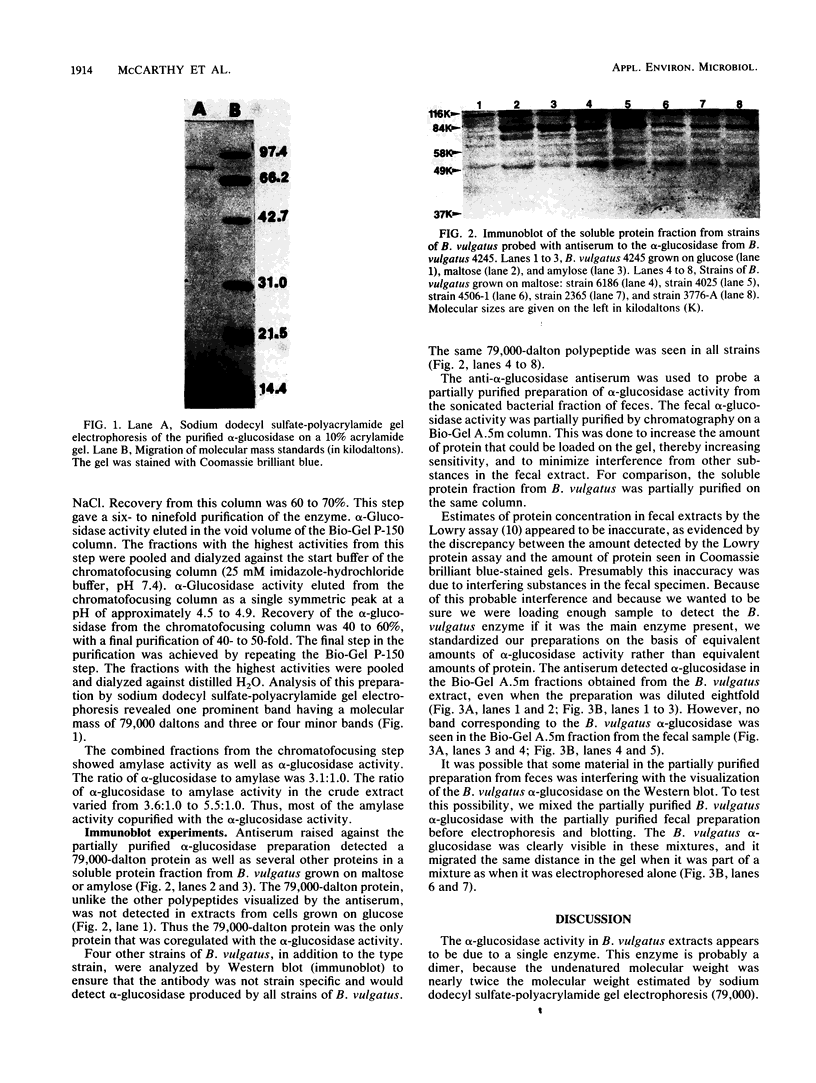Abstract
Bacteroides vulgatus is the numerically predominant Bacteroides species in the human colonic microflora. Unlike other colonic Bacteroides species, B. vulgatus is not a versatile utilizer of polysaccharides. The only types of polysaccharide that support rapid growth and high growth yields by all strains are the starches amylose and amylopectin. Amylase and alpha-glucosidase activities are among the highest found in a bacterial fraction obtained from human feces. This observation raised the question of whether B. vulgatus was the source of the fecal enzymes. Both alpha-glucosidase and amylase were produced at 20- to 40-fold-higher levels when B. vulgatus was grown on maltose, amylose, or amylopectin than when B. vulgatus was grown on glucose or other monosaccharides. Both enzymes had the same pI (4.6 to 5.0) and undenatured molecular weight (150,000). The pIs and molecular weights of the B. vulgatus amylase and alpha-glucosidase were the same as those of the fecal enzymes. To determine whether the B. vulgatus alpha-glucosidase was identical to the fecal alpha-glucosidase, we partially purified the B. vulgatus enzyme and raised an antiserum against it. Using this antiserum, we showed that all strains of B. vulgatus produced the same enzyme. The antiserum did not detect the B. vulgatus alpha-glucosidase in the bacterial fraction from human feces, even when a partially purified preparation of the fecal enzyme was used. Thus the alpha-glucosidase activity in the bacterial fraction from human feces is not the B. vulgatus enzyme.
Full text
PDF





Images in this article
Selected References
These references are in PubMed. This may not be the complete list of references from this article.
- Bradford M. M. A rapid and sensitive method for the quantitation of microgram quantities of protein utilizing the principle of protein-dye binding. Anal Biochem. 1976 May 7;72:248–254. doi: 10.1006/abio.1976.9999. [DOI] [PubMed] [Google Scholar]
- Dygert S., Li L. H., Florida D., Thoma J. A. Determination of reducing sugar with improved precision. Anal Biochem. 1965 Dec;13(3):367–374. doi: 10.1016/0003-2697(65)90327-1. [DOI] [PubMed] [Google Scholar]
- Englyst H. N., Cummings J. H. Digestion of polysaccharides of potato in the small intestine of man. Am J Clin Nutr. 1987 Feb;45(2):423–431. doi: 10.1093/ajcn/45.2.423. [DOI] [PubMed] [Google Scholar]
- Englyst H. N., Cummings J. H. Digestion of the carbohydrates of banana (Musa paradisiaca sapientum) in the human small intestine. Am J Clin Nutr. 1986 Jul;44(1):42–50. doi: 10.1093/ajcn/44.1.42. [DOI] [PubMed] [Google Scholar]
- Ford J. R., Nunley J. A., 2nd, Li Y. T., Chambers R. P., Cohen W. A continuously monitored spectrophotometric assay of glycosidases with nitrophenyl glycosides. Anal Biochem. 1973 Jul;54(1):120–128. doi: 10.1016/0003-2697(73)90254-6. [DOI] [PubMed] [Google Scholar]
- Kotarski S. F., Linz J., Braun D. M., Salyers A. A. Analysis of outer membrane proteins which are associated with growth of Bacteroides thetaiotaomicron on chondroitin sulfate. J Bacteriol. 1985 Sep;163(3):1080–1086. doi: 10.1128/jb.163.3.1080-1086.1985. [DOI] [PMC free article] [PubMed] [Google Scholar]
- Kuritza A. P., Salyers A. A. Use of a species-specific DNA hybridization probe for enumerating Bacteroides vulgatus in human feces. Appl Environ Microbiol. 1985 Oct;50(4):958–964. doi: 10.1128/aem.50.4.958-964.1985. [DOI] [PMC free article] [PubMed] [Google Scholar]
- LOWRY O. H., ROSEBROUGH N. J., FARR A. L., RANDALL R. J. Protein measurement with the Folin phenol reagent. J Biol Chem. 1951 Nov;193(1):265–275. [PubMed] [Google Scholar]
- Laemmli U. K. Cleavage of structural proteins during the assembly of the head of bacteriophage T4. Nature. 1970 Aug 15;227(5259):680–685. doi: 10.1038/227680a0. [DOI] [PubMed] [Google Scholar]
- McCarthy R. E., Salyers A. A. Evidence that polygalacturonic acid may not be a major source of carbon and energy for some colonic Bacteroides species. Appl Environ Microbiol. 1986 Jul;52(1):9–16. doi: 10.1128/aem.52.1.9-16.1986. [DOI] [PMC free article] [PubMed] [Google Scholar]
- Moore W. E., Holdeman L. V. Human fecal flora: the normal flora of 20 Japanese-Hawaiians. Appl Microbiol. 1974 May;27(5):961–979. doi: 10.1128/am.27.5.961-979.1974. [DOI] [PMC free article] [PubMed] [Google Scholar]
- Salyers A. A., Vercellotti J. R., West S. E., Wilkins T. D. Fermentation of mucin and plant polysaccharides by strains of Bacteroides from the human colon. Appl Environ Microbiol. 1977 Feb;33(2):319–322. doi: 10.1128/aem.33.2.319-322.1977. [DOI] [PMC free article] [PubMed] [Google Scholar]
- Salyers A. A., West S. E., Vercellotti J. R., Wilkins T. D. Fermentation of mucins and plant polysaccharides by anaerobic bacteria from the human colon. Appl Environ Microbiol. 1977 Nov;34(5):529–533. doi: 10.1128/aem.34.5.529-533.1977. [DOI] [PMC free article] [PubMed] [Google Scholar]
- Stiefel D. J., Keller P. J. Preparation and some properties of human pancreatic amylase including a comparison with human parotid amylase. Biochim Biophys Acta. 1973 Apr 12;302(2):345–361. doi: 10.1016/0005-2744(73)90163-0. [DOI] [PubMed] [Google Scholar]
- Varel V. H., Bryant M. P. Nutritional features of Bacteroides fragilis subsp. fragilis. Appl Microbiol. 1974 Aug;28(2):251–257. doi: 10.1128/am.28.2.251-257.1974. [DOI] [PMC free article] [PubMed] [Google Scholar]
- Vercellotti J. R., Salyers A. A., Wilkins T. D. Complex carbohydrate breakdown in the human colon. Am J Clin Nutr. 1978 Oct;31(10 Suppl):S86–S89. doi: 10.1093/ajcn/31.10.S86. [DOI] [PubMed] [Google Scholar]





